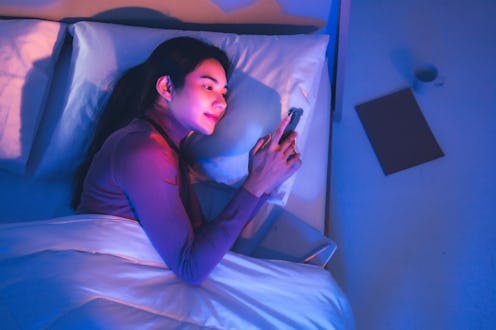Wellness
What Happens To Your Body When You Use Dark Mode On Your Phone

Once the domain of edgy programmers and hackers in '90s TV shows, dark mode, where text and programs show up as white letters on a black screen on your phone or laptop, has entered the mainstream. People use it to decrease eye strain; the theory goes that white backgrounds emit a lot of glare that can hurt your eyes. Experts tell Bustle it's not actually that simple, unfortunately. Dark mode might affect your body in several ways, but it's not guaranteed to help your eyes.
"There was some concern initially about the intensity of blue light that comes from bright white screens and if this would have an impact on eye health," Dr. Benjamin Bert M.D., an ophthalmologist at MemorialCare Orange Coast Medical Center, tells Bustle. "To this point, there is no definitive evidence that blue light from screens is dangerous. However, we do know that the blue light can affect the sleep-wake cycle and impact our quality of sleep."
Our eyes are highly sensitive to light, and a study in Current Biology in 2019 found that bright light of all kinds, including yellow and blue light, can disrupt sleep patterns. Brighter light sends a signal that it's daytime, stopping the brain's production of melatonin, a hormone that makes you sleepy. Shifting to a dimmer screen may stop your eyes from transmitting wide-awake signals to your brain, and indicate that it's time for the body to rest. "It is true that dark mode has less light in general, so you could postulate that it would be a little bit better at preventing sleep problems," Dr. Bert says.
Dark mode can also affect people who have astigmatism, a common condition where vision becomes blurred because of the curvature of the eye. A study published in Ergonomics in 2013 found that for people with standard vision in the daytime, white text on a black background is often better for proofreading and clear vision. A person with astigmatism in one or both eyes, though, might experience problems reading in dark mode. People with astigmatism may find that white letters begin to bleed into the black background during dark mode, making them harder to read. It's a phenomenon known as halation. If you can't really focus when your phone's on dark mode, you may need to get an eye test.
Being in a bright room can make a difference to dark mode's efficiency. "Your reading comfort will vary with external lighting situations, so you may find greater comfort in dark mode in some situations but not others," Dr. Howard Krauss, M.D., a surgical neuro-ophthalmologist at Providence Saint John's Health Center, tells Bustle. A study published in 2017 in Applied Ergonomics found that at night, participants were better at reading tasks using 'light mode' (black text on white backgrounds) than in dark mode. It was also very hard for them to read tiny letters in dark mode in low-light conditions.
The American Academy of Ophthalmology (AAO) tells Bustle that there are some merits to dark mode, particularly if it shifts other tones on device screens as well. If your phone or laptop has a "night mode," it might combine dark backgrounds with a shift towards pink and red light instead of blue light. "The contrast and colors used in night mode help our eyes adjust more easily to surrounding light, leading to less eye strain and easier, comfortable reading," the AAO says. Night mode is also designed to help increase melatonin production and make it easier to sleep, but it's not clear whether it helps much. "Much more research is needed to see which is better, night shift or dark mode, in preventing sleep disruption or eye strain or fatigue," Dr. Bert says.
At the end of the day, Dr. Krauss says, dark mode's benefits are very individual. "Use the mode which is most comfortable for you," he says. "Go ahead and experiment with it; this is one circumstance where it’s safe to do what feels good."
Experts:
American Academy of Ophthalmology (AAO)
Dr. Benjamin Bert M.D.
Dr. Howard Krauss M.D.
Studies cited:
Dobres. J., Chahine, N., Reimer, B.(2017). Effects of ambient illumination, contrast polarity, and letter size on text legibility under glance-like reading, Applied Ergonomics. DOI: 10.1016/j.apergo.2016.11.001
Mouland, J. W., Martial, F., Watson, A., Lucas, R. J., & Brown, T. M. (2019). Cones Support Alignment to an Inconsistent World by Suppressing Mouse Circadian Responses to the Blue Colors Associated with Twilight. Current biology : CB, 29(24), 4260–4267.e4. https://doi.org/10.1016/j.cub.2019.10.028
Piepenbrock, C., Mayr, S., Mund, I., & Buchner, A. (2013). Positive display polarity is advantageous for both younger and older adults. Ergonomics, 56(7), 1116–1124. https://doi.org/10.1080/00140139.2013.790485
This article was originally published on